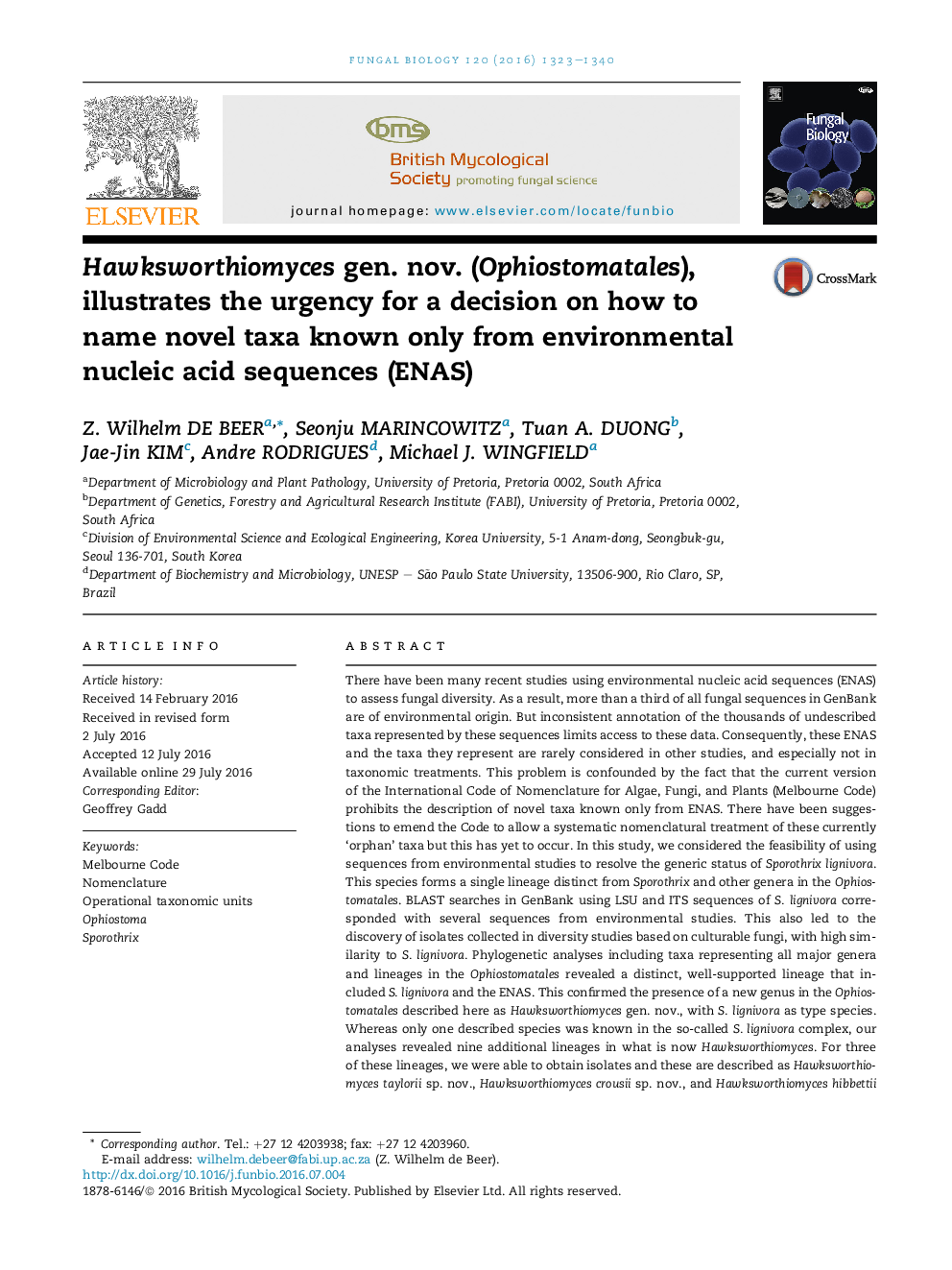| کد مقاله | کد نشریه | سال انتشار | مقاله انگلیسی | نسخه تمام متن |
|---|---|---|---|---|
| 4356719 | 1412105 | 2016 | 18 صفحه PDF | دانلود رایگان |

• Phylogenies including unnamed fungal sequences of environmental origin reveal a new genus.
• Hawksworthiomyces gen. nov. is described in the Ophiostomatales.
• Three new Hawksworthiomyces species are described based on living cultures.
• One species, Hawksworthiomyces sequentia sp. nov. ENAS, is described with only a DNA sequence as type.
• This case study provides an example of the added value that environmental sequences can bring to taxonomic studies.
There have been many recent studies using environmental nucleic acid sequences (ENAS) to assess fungal diversity. As a result, more than a third of all fungal sequences in GenBank are of environmental origin. But inconsistent annotation of the thousands of undescribed taxa represented by these sequences limits access to these data. Consequently, these ENAS and the taxa they represent are rarely considered in other studies, and especially not in taxonomic treatments. This problem is confounded by the fact that the current version of the International Code of Nomenclature for Algae, Fungi, and Plants (Melbourne Code) prohibits the description of novel taxa known only from ENAS. There have been suggestions to emend the Code to allow a systematic nomenclatural treatment of these currently ‘orphan’ taxa but this has yet to occur. In this study, we considered the feasibility of using sequences from environmental studies to resolve the generic status of Sporothrix lignivora. This species forms a single lineage distinct from Sporothrix and other genera in the Ophiostomatales. BLAST searches in GenBank using LSU and ITS sequences of S. lignivora corresponded with several sequences from environmental studies. This also led to the discovery of isolates collected in diversity studies based on culturable fungi, with high similarity to S. lignivora. Phylogenetic analyses including taxa representing all major genera and lineages in the Ophiostomatales revealed a distinct, well-supported lineage that included S. lignivora and the ENAS. This confirmed the presence of a new genus in the Ophiostomatales described here as Hawksworthiomyces gen. nov., with S. lignivora as type species. Whereas only one described species was known in the so-called S. lignivora complex, our analyses revealed nine additional lineages in what is now Hawksworthiomyces. For three of these lineages, we were able to obtain isolates and these are described as Hawksworthiomyces taylorii sp. nov., Hawksworthiomyces crousii sp. nov., and Hawksworthiomyces hibbettii sp. nov. Five of the lineages each included one or more sequences from single studies, and thus remain unnamed. The remaining lineage included two sequences from separate studies of fungi inhabiting conifer wood. One of these sequences was an uncultured fungus clone from a spruce log in Sweden. The other sequence was for an isolate from a western red cedar fencepole in British Columbia, Canada, that was subsequently lost. These two ITS sequences differ in only two nucleotide positions. We are confident that they represent the same taxon and meet the criteria for an ENAS species, for which we provide the name, Hawksworthiomyces sequentia sp. nov. ENAS, and designate a DNA sequence as type in the absence of a type specimen. This case study makes it clear that environmental sequences and those from lost isolates can be extremely valuable in phylogeny-based taxonomic studies. It emphasises the fact that the Code should be emended to enable the naming of such taxa in a manner that will facilitate their incorporation in other studies.
Journal: Fungal Biology - Volume 120, Issue 11, November 2016, Pages 1323–1340